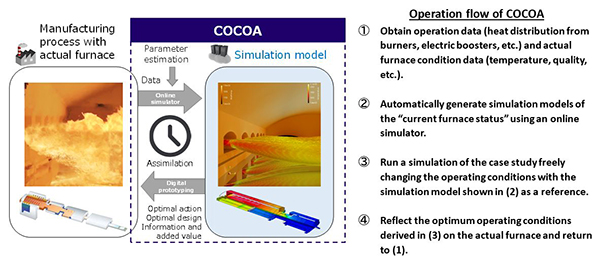
AGC Inc. developed the CadTank Online Computation and Optimization Assistant, or COCOA, as a digital twin technology for the glass melting process that integrates an online simulator with a digital prototyping tool.
Full-scale operational verification at AGC’s float furnaces is scheduled to begin in February 2023. This technology enables a rapid and detailed understanding of the glass melting process and a preliminary study of production conditions, which have been difficult to achieve in the past.
What is it?
A digital twin is a virtual model designed to accurately reflect a physical object. The object being studied is outfitted with various sensors related to vital areas of functionality. These sensors produce data about different aspects of the physical object’s performance such as energy output, temperature, weather conditions and more.
Why is it needed?
The temperature inside a float furnace and the flow of molten glass change daily depending on various factors such as the condition of the raw materials and refractories, which greatly impacts the quality of the glass produced. As these factors change, it becomes necessary to re-derive optimal operating conditions. Yet this adjustment requires time, and the production volume declines during this period.
The inside of a float furnace is searing at approximately 2,900 degrees Fahrenheit, so it is difficult to obtain a detailed understanding of the internal conditions. Therefore AGC had been using CadTank, a glass melting process simulation technology originally developed in the 1970s, but it was difficult to run simulations in a timely manner due to major effort required to collect the necessary data.
To solve these issues, AGC developed the simulation tool COCOA, which can check changes in temperature distribution inside a float furnace, the flow of molten glass, etc. from a simulation model automatically generated using float furnace operation data.
How it will help
This enables process technicians to easily and directly conduct detailed condition assessments and preliminary studies of production conditions inside the glass melting process, which previously required simulation specialists to take time to implement. In the future, AGC will build an efficient production system based on simulation forecasts and utilize this system for sustainability to reduce GHG emissions.
As the next step in the development of digital twin technology, AGC is working on automatically estimating information that is difficult to measure and necessary to run simulations, using a technique called “data assimilation.” Once this is achieved, the real-time forecasting accuracy of digital twin technology will be further improved and its use will be expanded. By enabling anyone to use simulation technology through the digital twin, AGC will further expand its accumulated strengths in simulation technology and develop it into a differentiation technology.

